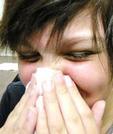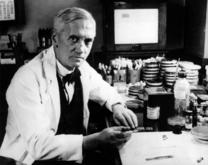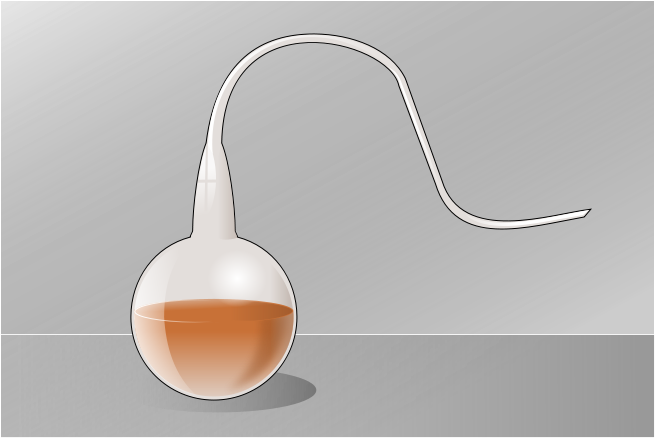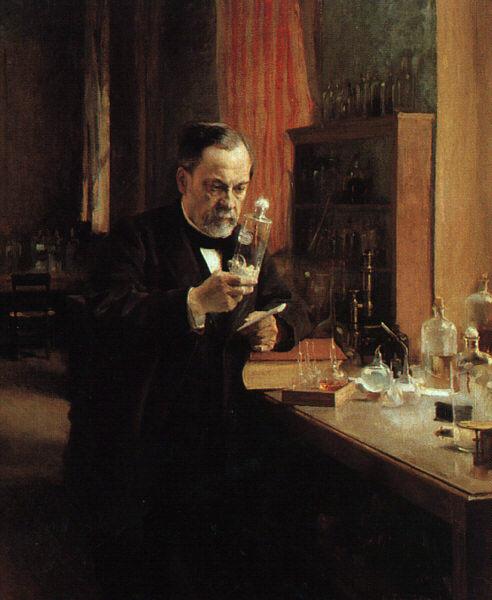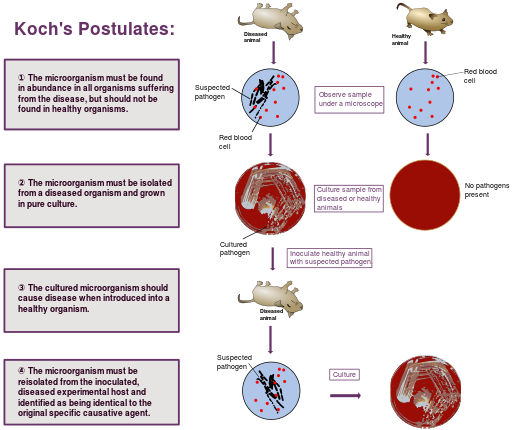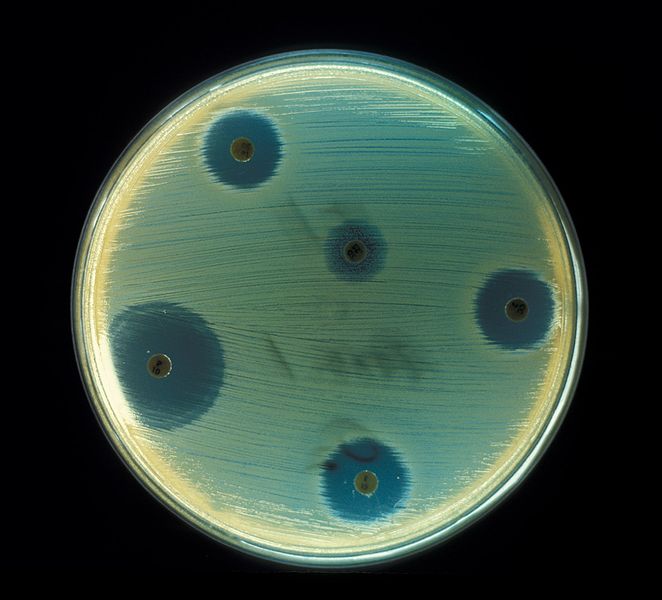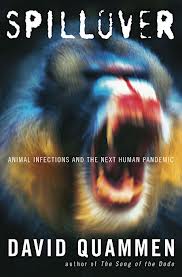 | ||||
Late Germ Theory
Contributions of Pasteur, Lister, Koch, Domagk & Fleming
CLASS NOTES from Science Prof Online
Key to the development of Germ Theory, and the understanding of infectious disease, was the refutation of spontaneous generation; the idea that, on a daily basis, living things can arise from non-living matter.
Article Summary: Germ Theory is the concept that microorganisms can cause disease, and this theory is the foundation of modern medicine. Here is a summary of some key discoveries.
Late Germ Theory: Pasteur, Lister, Koch, Domagk & Fleming
Alexander Fleming discovered the antibiotic penicillin.
SCIENCE PHOTOS
 | ||||||
SPO VIRTUAL CLASSROOMS
What was actually being observed, in many instances, was the appearance of visible organisms or populations of organisms which arose from microscopic precursors. For example, it only takes one bacterial cell to, in a matter of days, give rise to millions of daughter cells, or minute aphid eggs to quickly give rise to visible adult aphids.
Important Early Microbiologists
There were many involved in the triumph of Germ Theory, but here is a summary of some of the key players. Those italicized are covered in this article. The names not italicized are covered in the Early Germ Theory article.
- van Leeuwenhoek, Antonie (1670s)
- Semmelweis, Ignaz (1840s)
- Snow, John (1850s)
- Pasteur,Louis (1860s)
- Lister, Joseph (1860s)
- Koch, Robert (1870s)
- Domagk, Gerhard & Fleming, Alexander (1920s & 1930s)
Pasteur, a French scientist who made great contributions to our understanding of microbiology and for whom the process of “pasteurization” is named, brought to light strong evidence that microbes arise from other microbes, not spontaneously.
The End of Spontaneous Generation
After boiling nutrient broths in his special flasks, Pasteur found that these swan-necked containers would remain free of microbes until he broke the necks of the flasks, allowing particles from the air to drift in. It was the carefully controlled experiments of Pasteur that finally put to rest the debate over spontaneous generation.
Joseph Lister the Father of Modern Antisepsis (1860s)
Despite previous discoveries to the contrary, a prevailing belief persisted that wound infection was due to tissue exposed to stinking "miasma" in air, and it was still considered unnecessary for a surgeon to wash his hands before seeing a patient.
Pasteur’s Swan-Necked Flasks
Pasteur created unique glass flasks with unusual long, thin necks that pointed downward. These “swan-necked” flasks allowed air into the container but did not allow particles from the air to drift down into the body of the flask.
Check out an animated lesson on Pasteur's spontaneous generation experiment.
Portrait of Louis Pasteur in his laboratory.
In addition to his postulates, Koch played an important role in the use of agar as solid medium, and invented nutrient broth and nutrient agar for controlled growth of microorganisms in the laboratory setting.
The Discovery of Antimicrobials (1930s)
Gerhard Domagk and Sulfa Drugs: German pathologist and bacteriologist, Domagk discovered that the dye Prontosil was effective against a wide range of bacteria. The sulfanilamide portion of the Prontosil molecule is responsible for its antibacterial effect, hence, the name sulfa drugs. In 1939, Domagk received the Nobel Prize in Medicine for this discovery.
Modern antibiotics are tested using a method similar to Fleming's discovery. Antibiotic disks on a plate inoculated with Staph aureus. Note "zones of inhibition" where bacteria won't grow around the disks.
You have free access to a large collection of materials used in a college-level introductory microbiology course. The Virtual Microbiology Classroom provides a wide range of free educational resources including PowerPoint Lectures, Study Guides, Review Questions and Practice Test Questions.
 | ||||||
SPO is a FREE science education website. Donations are key in helping us provide this resource with fewer ads.
Please help!
(This donation link uses PayPal on a secure connection.)
Aristotle & Spontaneous Generation
According to Aristotle, it was "readily observable that aphids arise from the dew on plants, fleas from putrid matter", and mice from dirty hay; and this belief remained unchallenged for more than two thousand years.
Lister read a paper by Pasteur showing that rotting could occur if micro-organisms present and thought that perhaps microorganisms were causing the rotting wounds.
In his publication, Pasteur had suggested three different methods to eliminate microorganisms:
- filter them out
- heat them up
- expose them to chemical solutions
The first two methods were inappropriate for use in human wounds, so Lister experimented with the third.
Carbolic acid was used at the time for deodorizing sewage, so Lister tried spraying instruments, surgical incisions, wounds and dressings with solution. It markedly reduced the incidence of gangrene. This led to the rise of sterile surgery and Lister being recognized as the father of antiseptic surgery.
Robert Koch’s Postulates (1870s)
Koch, a German physician, developed a sequence of experimental steps for directly relating a specific microbe to a specific disease, and in doing so was able to isolate:
- Bacillus anthracis (the bacterium causing anthrax)
- Mycobacterium tuberculosis (the bacterium causing tuberculosis)
- Vibrio cholera (the bacterium causing cholera)
Alexander Fleming and Penicillin: Fleming, a British bacteriologist, discovered penicillin by accident when observing that some of the bacterial colonies he was studying were disappearing on plates that were contaminated with mold. Fleming extracted the compound in the mold that was responsible for destruction of the bacterial colonies. The product was named penicillin, after the Penicillium mold from which it was derived.
Sources & Resources
- Bauman, R. (2014) Microbiology: Diseases by Taxonomy, 4th ed, Pearson Benjamin Cummings.
- Microbial Control Microbiology Laboratory Exercise Main Page from the Virtual Microbiology Classroom.
- Park Talaro, K. (2008) Foundations in Microbiology, McGraw-Hill.
- History of Microbiology Lecture Main Page from Science Prof Online.
Page last updated 1/2016
- Spillover by Quammen
- Rabid by Wasik & Murphy
- The Viral Storm by Wolfe
- The Ghost Map by Johnson
- Missing Microbes by Blaser
- The Great Mortality by Kelly
-The Great Influenza by Berry
- Pandemics: What Everyone Needs to Know by Doherty
- Deadly Outbreaks by Levitt
- Microbe Hunters by De Kruif
- Wickett's Remedy by Goldberg
- The Dress Lodger by Holman
SCIENCE VIDEOS
